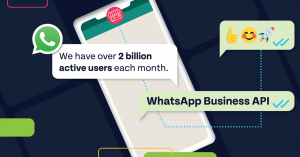Elevating the Customer Experience with the WhatsApp Business API
People all across the planet love WhatsApp. It is the most popular global messaging channel, with more than two billions active users each month using it to communicate with family and friends. WhatsApp is also the most popular message app for all age groups - making it a tremendous tool to connect with people in every demographic and from all walks of life. WhatsApp Business is a specific app offered by WhatsApp to enable businesses to send and receive messages with their customers. It provides tools to communicate with people through a combination of automation and real-time messaging capabilities and is designed to function just like WhatsApp Messenger. WhatsApp Business builds on users’ love and loyalty for the app, adding in features that give companies the ability to service customers, sell products, and services, and build brand loyalty. Businesses can create profiles, set up auto responses, easily segment customers for marketing efforts, and see metrics on how the messages you send to your consumers are sent, delivered, read, and received. It’s catching on quickly. There are already more than 50 users of the WhatsApp Business app to connect with their customers. WhatsApp Business API for Medium to Large Companies The WhatsApp Business API goes a step further, enabling enterprise companies to tap into WhatsApp’s code to get deeper insights and add their own features and integrations. As an authorized WhatsApp Business Solution Provider, Clickatell makes leveraging the WhatsApp Business API simple and straightforward for medium to large companies everywhere that want to build their brands and strengthen customer connections. The rewards of doing so are many and significant. Put simply, it pays for businesses to use WhatsApp Business. Research shows that an impressive 55% of customers are willing to pay more for a “guaranteed good customer experience .” A full 72% of customers will share a positive experience with 6 or more people. Conversely, 13% tell 15 or more people if they’re unhappy with a business experience. WhatsApp allows businesses to talk with customers in real time, answer questions, solve problems and, in the future, buy goods and services. Key Ways WhatsApp Business Elevates Customer Experience: Increase open and response and rates The best marketing is only effective if your audience sees it; reaching your audience and customers is the name of the game. The average open rate in WhatsApp is an impressive 98% , compared with 22% for email campaigns. The reason is simple: your customer has already opted-in to receive messages from you by providing their number and adding your number to their contacts. And if they’re willing to do this, more likely than not, they are they are willing to read your messages. Response rates bear this out. Our recent Aberdeen ROI Report research shows that companies using chat capabilities address consumer needs were able to do so more swiftly and efficiently. As a result, they decreased their customer effort by 10.8x (4.3% vs. 0.4%) and grow customer retention rates by 48% YoY (7.4% vs. 5.0%). The result is an impressive bump in the ROI of your marketing activities. Companies with chat-enabled commerce activities report an astounding 20.7x greater YoY increase in return on marketing investments (ROMI), compared to firms without chat capabilities (6.2% vs. 0.3%). Converse with context anytime Chat allows for better customer engagement by putting the power in the customer’s hand, letting them start—and pause—an interaction and return when it is convenient, without losing the thread and context. It also saves time, both for your customer service agents and your customers, particularly when dealing with common requests. The ability to see a customer’s account in the moment, and to give and receive immediate feedback as they try various fixes or options, cuts down dramatically on miscommunication and confusion. On the flip side, if the customer wants to pause the conversation and come back later, it’s easy to pick up where things left off by referencing the full context of the interaction. Directly deliver more personalized updates and offers WhatsApp puts you in your customer’s address book and gives you direct, personal access. When you send a message, it arrives instantly, popping up on their phone. Customers don’t need to check their email accounts. There’s no risk of your emails sitting untouched in an inbox or spam folder. What’s more, because you can easily access and understand customer behavior, your marketing can be extremely personalized and targeted. You can segment your audience by customers’ needs and previous interactions with your company, and fine-tune offers and messaging appropriately. This further enhances connection and loyalty—and incites action. Streamline and enhance customer support Today’s customers simply do not want to wait to raise issues, ask questions, get product information, or purchase products. When your company offers support through WhatsApp Business, they don’t have to. WhatsApp Business allows for better customer engagement by putting the power in the customer’s hand, letting them start—and pause—an interaction and return when it is convenient, without losing the thread and context. It also saves time, both for your customer service agents and your customers, particularly when you are able to automate common requests. For example, global health service leader Cigna wanted to reduce the volume of customer calls, while at the same time increasing customer satisfaction and offering an additional self-service tool for post-purchase customer care to a local patient group. By using a WhatsApp-powered virtual assistant they achieved a 3X faster response time for customer inquiries and an impressive 91% customer query resolution rate . WhatsApp Business also enables customers to escalate issues and connect with live customer service agents when they want to or need to. Clickatell just launched Chat Flow , a Chat Commerce workflow builder that makes it easy for brands to interact with consumers on WhatsApp and other chat apps. Chat Flow’s app-like functionality on trusted chat channels provides consumers with in-depth product information, issue resolution, and the ability to interact and make purchases within a chat conversation. Get started with WhatsApp Business today WhatsApp Business is an opportunity to gain a serious competitive advantage—and the results of doing so are significant. Companies incorporating chat capabilities that enable consumers to have an effortless experience enjoy 75% greater year-over-year (YoY) growth in annual revenue (10.7% vs. 6.1%). Want to join their ranks? Let us show you how Clickatell’s WhatsApp Business API can help you leverage WhatsApp Business for your enterprise.



